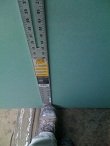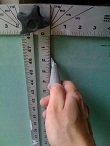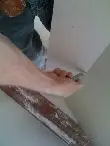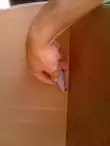
How to cut Drywall Panels
Drywall can be cut easily with a straight edge and utility knife. Drywall is basically a layer of ground gypsum sandwiched between two thick sheets of paper. The drywall paper strengthens the gypsum and provides a surface that is easily painted once finished. To cut drywall you must simply cut the paper on both sides of the gypsum and the gypsum within will break easily along this line. Follow the instructions below for cutting a full sheet of drywall.

Step 1
Measure the board to be cut and place a T-square where the board should be cut. The T-square serves as a straight edge along which to cut the drywall.

Step 2
Place your foot at the bottom of the T-square to hold it in place. If this is not done, the T-square could swing out at the bottom and your cut will be crooked. Leave your foot on the T-square while cutting to anchor it in place.

Step 3
Using a utility knife, score the paper by cutting along the right hand side of the T-square starting from the top of the sheet of drywall and moving down. Once you have cut more than halfway down the board, turn the knife over and cut from the bottom of the board to finish the cut.

Step 4
Lift the board slightly and bend it gently to break the gypsum along this line. The paper on the back of the board will still be in tact holding the board together.

Step 5
Cut the paper on the back of the sheet of drywall. This will completely separate the two pieces. Clean the cut edge by running a rasp along the freshly cut board to grind off the rough edges.
Making angle cuts in drywall
The above instructions do not cover techniques to perform the endless angle cuts that you will need to make, nor the technique to ripping a sheet of drywall along the long direction. There are various carpenter techniques to calculate angles and distances for cutting drywall. The basics outlined above still apply. Cutting a sheet of drywall involves cutting the paper on either side of the board and bending the board to break the gypsum within. Many professionals use chalk lines to lay out the pattern on the sheet of drywall before cutting.
Cutting around pipes and electrical boxes
When installing drywall, the rough electrical and plumbing has already been completed on a project and there are some areas where the drywall needs to be cut to allow for finish fixtures. There are manual circle cutting tools available for cutting circles larger than three inches in diameter. An invaluable tool is a keyhole saw. This is basically a long thin blade with rough saw-like teeth attached to a handle. It easily pushes through drywall and can cut a hole in the middle of a sheet of drywall. Many electricians use a keyhole saw to cut small holes in drywall that has already been installed. A keyhole saw is a quick and efficient way to cut small holes or angles in the middle of a sheet.
Most professionals rely heavily on light duty electric routers with a bit specially made for drywall. The end of the bit has an edge that guides it around electrical boxes or window frames while the rest of the bit cuts through drywall. It allows you to hang a sheet of drywall over top of electrical boxes and cut them out once the sheet is tacked in place with a few screws. One popular brand is RotoZip®, in fact the name is almost synonymous with drywall routers. This greatly increases speed because you can spend less time measuring exact cuts and more time installing drywall. Using a router to cut drywall is not for the beginner. You need specific training from a skilled professional to be able to operate a router.
Be safe when using a utility knife!
Using a utility knife has obvious inherent dangers. One of the most common injuries when cutting drywall occurs while running the knife along the edge of the T-square. The knife can easily slip from the drywall and run along the face of the T-square. If your hand is in the path of the knife you may quickly find yourself in the emergency room getting stitches on most likely your thumb or perhaps your index finger. Always pull the knife away from your body, never toward your body. Be aware of the location of your hand as you hold the T-square and try not to have it located along the path you are cutting. Be aware of the dangers inherent to utility knife use and use safe working practices. If you have any questions, consult with a trained professional.

